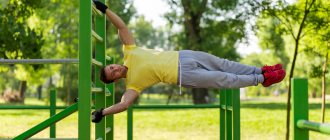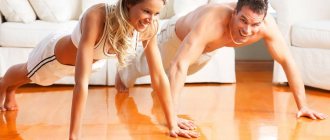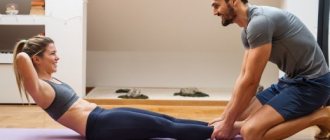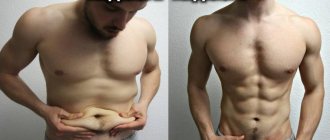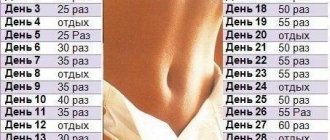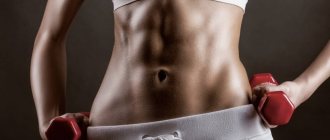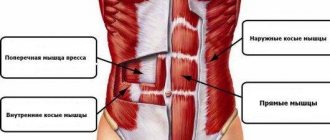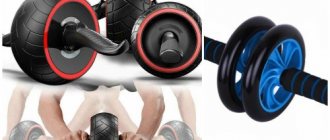Author of the article
Andrey Belozertsev
Drawing up programs for effective muscle mass gain.
Physical activity is extremely important for girls in adolescence, as it not only forms a beautiful figure, but also promotes health.
A toned stomach is an essential attribute of a young, developing figure.
In this material we will figure out how to pump up the abs for a girl 12 years old and older, what is special about children’s training, and how to eat properly and develop harmoniously for teenagers.
What is important to consider when performing abdominal exercises?
When a teenager does exercises, he must use his abs. Many teenagers make mistakes when playing sports. Pump up your abs, making efforts with your legs. Or backs. As a result, the cubes do not appear. Because the main load goes on the back and legs. And the abs are not used during the exercises.
What exercises should you do to pump up your abs?
To get beautiful abs, a teenager will need to do different types of exercises. Not only dynamic (bicycle), but also static. Such as a plank.
If a teenager alternates static and dynamic exercises, this will have a positive effect on the formation of his muscles. He will have beautiful abs. And a so-called muscle ring will be created. Beautiful relief over the entire area of the abdomen.
The essence of weight loss exercises for teenagers
An important task for parents of an overly plump child is to accustom him to sports and physical training. This does not mean that you should immediately send your son or daughter to the gym. There are special weight loss exercises for teenagers that are easy to do at home.
Loading different muscle groups should be done gradually, starting with simple exercises. The duration of exercise for teenagers should not be less than 40 minutes a day, only during this time the body will begin to work on breaking down fat deposits. Fitness trainers do not recommend exercising for more than an hour, as fatigue and loss of strength sets in.
Complexes of physical exercises for teenagers should be performed 3 times a week. It is best to do exercises for teenage children in the first half of the day; more than an hour should pass after eating. After training, you should also not eat for one and a half to two hours.
Sports training should always be preceded by a warm-up. These are the usual bends, squats, rotation of arms and legs, running in place or in a circle. Now that the body has already warmed up, let’s begin weight loss exercises for teenagers.
In young people of the teenage category, metabolism occurs much faster than in adults, so there is no need to invent any special exercises. First of all, pay attention to cardio exercises - running, race walking, jumping rope and aerobics.
In order for the child’s weight to return to normal, it is better to trust the professionals. An excellent option would be to send your child to a club. There, the trainer will select the right loads, the teenager will not only lose excess weight, but also acquire certain skills. Dancing or aerobics are suitable for girls, while boys will be interested in football, basketball, hockey, as well as various martial arts.
How to pump up beautiful abs?
To get beautiful abs, just doing exercises for them is not enough. A teenager must follow a diet. Eat the right foods. In limited quantities.
This is necessary to ensure that the amount of belly fat in a teenager is minimal. If a teenager does not eat properly, he can do abdominal exercises endlessly. But this will not bring results. The fat layer will overlap the cubes.
However, doing abdominal exercises also requires a lot of attention. Even if there is a layer of fat on the teenager’s body, his stomach will be toned. And it will look beautiful.
Belly fat needs to be reduced
You need to start building beautiful abs by fighting against the fat layer. For abs to appear on your belly, your fat level should be no more than 15%. Each person has their own optimal amount of body fat, at which pumped up abs are visible. For some people, their abs are hard to see even at 7% body fat. And for others they are perfectly drawn at 15%.
The teenager must determine the optimal amount of fat he should have. And based on this, formulate a weight loss strategy. If a teenager needs to lose weight, he must go on a diet. If he wants to improve the definition of his abdomen, then he must burn a lot of calories during training.
First aid kit for schoolchildren and teenagers
However, the most important thing at any age is health, in order to maintain it, sometimes it is necessary to take medications, recognize dangerous diseases in time, or provide first aid correctly and competently. A home first aid kit, collected by age, can help with this. But often parents have difficulties - what should be in the first aid kit if the child is already relatively old? Are “adult” medications acceptable for him?
Where to store a children's first aid kit?
If we are talking about school-age children and teenagers, it is worth allocating a separate box or section in the general family first aid kit for medicines and medical products. If this is a general first aid kit, medications for the child must be labeled or placed separately in labeled bags or compartments. Many drugs have age restrictions of 12–14 years, and some drugs have age restrictions of 18 years, so children should have their own medications.
Read also:
Adaptation difficulties: how to help a child minimize stress in a new team?
For example, the well-known aspirin (acetylsalicylic acid) is not recommended for use until the age of 15, and the use of metamizole sodium (analgin) in children's practice should be completely abandoned, although it is acceptable for use, but it has too dangerous side effects.
Separate storage is the best option so that in case of an emergency you do not confuse medications, which threatens not to improve the condition, but to worsen it, poisoning or side effects of not indicated drugs.
Important! It is not recommended to store a first aid kit in the bathroom or kitchen. Air humidity and sudden changes in temperature can lead to damage to the integrity of the packaging and deterioration of medications before the expiration date expires. Then the medicine can become poison! This is especially true for medicines in paper packages and powders, some solutions.
If a child has a chronic disease that requires constant or periodic courses of treatment, it is necessary to store it according to the recommendations on the packaging, in the original box or blister, along with the instructions. Sometimes you can simply forget the dosage regimen, and the instructions will not let you make a mistake with the dose and regimen. Some medications need to be stored only in the refrigerator; they need to be allocated a separate shelf that is closed so that the medications do not come into contact with food and drinks.
Important! Every 6 months you need to audit your first aid kit, throwing out medications that have expired, even if it was a couple of days ago. Using expired medications is very dangerous!
What is needed in a schoolchild's first aid kit?
The first thing you need in any first aid kit, be it a baby or a teenager, is a thermometer (thermometer)
. Although today pharmacies offer a large selection of thermometers, ranging from traditional mercury thermometers to electronic non-contact or forehead strip thermometers, the most accurate was and remains the traditional mercury thermometer. With an adult child, measuring temperature does not pose any danger; he can sit or lie down quietly during the measurement. To avoid the risk associated with a mercury thermometer if it breaks, always place it in a protective plastic case after taking measurements, and do not leave it in places where it can be easily dropped (bedside tables, tables, shelves).
Wound treatment products
– this is the second thing that schoolchildren and teenagers need in their first aid kit. Treatment of minor abrasions, cuts, and wounds is usually required. Basic list of drugs that may be needed in a first aid kit:
• Hydrogen peroxide 3% (convenient release form in plastic bottles with a dropper spout);
• Antiseptic solutions (miramistin, chlorhexidine) for washing wounds;
• Solutions of iodine 5%, brilliant green or fucorcin (there are plastic containers with a brush or lekkers);
• Adhesive plaster – regular, for fixing bandages, and bactericidal, for minor cuts and abrasions;
• Sterile bows – narrow and wide, for applying bandages and treating wounds;
• Sterile cotton wool and gauze;
• Remedy for burns (dexpanthenol in a spray or creams, ointments);
• Gels, ointments or creams with wound-healing, decongestant, antipruritic effects (fenistil-gel, “Rescuer” balm, cream with rutin);
• Cotton swabs for applying solutions, treating wounds and other manipulations;
• Tweezers, pipettes with a blunt tip for instilling medications;
• Scissors.
You can also supplement your first aid kit with a tube of regular baby cream. It helps soften and moisturize the skin, eliminates irritation and redness.
Medicines in the school first aid kit
First of all, allergies, colds and intestinal infections become a problem in school-age children; there may also be problems with stool and abdominal pain. Schoolchildren's first aid kit should have:
• Antipyretics based on paracetamol or ibuprofen. They can be in syrups or tablets, but only in children's dosages. The same drugs can be used for headaches, dental pain, or sunburn.
• Sorbent preparations in the form of powders, tablets, gels or other options. They are necessary for intestinal infections, poisoning, allergies. Use strictly according to instructions.
• Oral rehydration products (powders for solution preparation). They are necessary for vomiting and diarrhea to replenish fluid and salt losses. If such powders are not available, they can be replaced with salt solutions that are combined with strong, sweet tea with lemon.
• Antihistamines in tablets or drops. They are used for reactions to food, skin rashes with itching, hay fever and other forms of allergies. In addition, antihistamines are used for colds in allergy sufferers, if there is severe swelling in the nasopharynx, or for insect bites.
• Drops or sprays to relieve nasal congestion (vasoconstrictors) based on oxymetazoline or xylometazoline in an age-specific dosage. After 12 years, you can use “adult” drugs.
Important! Schoolchildren’s first aid kit should not be stocked with antibiotics or antimicrobial and antiseptic drugs to eliminate intestinal infections. All these drugs can only be prescribed by a doctor if there are clear indications. Moreover, you should not use these remedies yourself; you can seriously harm your child.
Medicines for chronic diseases
Often, by school age, children may already have chronic diseases of the digestive tract, respiratory tract or skin, or neurological abnormalities. In this case, the first aid kit is equipped with medications prescribed by the doctor. They can be divided into two categories:
• Drugs for urgent, emergency care;
• Drugs for a course or continuous use.
For example, for children prone to allergies with anaphylactic reactions, these could be ampoules with epinephrine and syringes (auto-injector), antihistamines for emergency measures. In addition, your medicine cabinet may contain oral medications to treat and prevent allergies.
For each group of medications, clear and understandable instructions for use should be written in case the help is not provided by parents. The instructions should indicate the doses of medications, methods of their administration and important nuances.
For children over 14 years old
At this age, it is permissible to use drugs for adults, unless the instructions for the products indicate a prohibition of use. Also, taking into account the pressures on modern children and the impact of stress, you can equip a teenager’s first aid kit, in addition to the remedies described above, with mild sedatives - tincture of valerian or motherwort, herbal preparations with a sedative effect.
Alena Paretskaya
Photo depositphotos.com
The opinion of the author may not coincide with the opinion of the editors
Teenager needs to improve his posture
Having beautiful abs with bad posture is impossible. Therefore, the teenager needs to pay special attention to correcting it. A teenager should try to walk outside more. Walk. And sit less in one place (at the computer).
Due to poor posture, the muscles located in the abdomen begin to relax. The tone of the press is deteriorating. The mass of the body moves from the abdominal muscles of the abdomen to the back. As a result, the abs receive absolutely no stress in everyday life. And does not stay in shape while walking.
Because of this, not only the teenager’s posture suffers. But also his abdominal muscles. They become weak.
Is it even possible for a 13, 14, 15 year old teenager to get pumped up?
In fact, it all depends on your genetics. It will be the hardest for guys who have arms like the legs of a sparrow , and whose ribs are more prominent than their abs. Gaining weight as a teenager is very difficult.
If you're a chubby lover of grandma's pies, then this will be a little easier for you.
The main difficulty will be nutrition. I remember my childhood and how we spent from morning to evening on the street and we clearly had no time for food. Everyone, with the exception of plump Seryozha, he always had a bun in his pocket.
Therefore, if you decide to become a pumped-up male, then be prepared for the fact that you will have to go home and eat on a schedule .
The next difficulty is that you won’t be able to push yourself too hard in the gym. The fact is that at this age the spine has not yet formed; if you give a large axial load, this can lead to dire consequences. Therefore, I would advise you to first use the services of a personal trainer.
But, despite all these difficulties, it is possible for a teenager to get pumped up. The main thing is that you have a desire and approach this matter responsibly.
The teenager needs to strengthen his core
The press is not only those muscles that are on the surface. It is connected to a huge number of internal tissues. And core muscles.
It’s wrong to pump up just one abs. A teenager absolutely needs to improve the condition of the entire body as a whole. Chest, biceps, legs, back. By doing a comprehensive workout, pumping up your abs is much easier.
A teenager needs to develop not only external, but also internal abdominal muscles.
Most of the exercises in which the abs are pumped are aimed at improving the relief of only the outer part of the abdominal muscles. Leaving the internal muscles, at the same time, without attention. Although they need to be pumped in order to make the child’s belly fit.
To improve internal muscles, we recommend that your teenager use an exercise called the plank. And also to the vacuum of the stomach.
The press needs to be pumped correctly
It is necessary to pump up the press systematically and competently. We do not recommend that a teenager do one hundred repetitions every day. This will not bring the desired result.
Instead, workouts should be divided into weeks. Do several exercises every other day. For example, on Mondays, Wednesdays and Fridays.
At the same time, it is recommended to do each exercise in three to four approaches. No less than ten to fifteen repetitions. If you perform abdominal exercises systematically, it will be more effective than every day, but a hundred times.
The teenager needs to pay special attention to the technique. If it is bad, then there will be no point in such exercises.
Teenagers must learn to engage their abs during exercise
When a teenager performs abdominal exercises, he must ensure that the abdominal muscles receive stress. They must tense up during exercise. Otherwise, the exercises will not have an effect.
Ab exercises
According to scientists, the most effective abdominal exercises are their dynamic form. For example, leg lifts. Or a bicycle. If a teenager follows the execution technique, he will be able to pump up his abs more effectively than if he does crunches. Or do exercises on a fitball.
A teenager should not forget about statistical exercises
Statistical exercises are also important for developing beautiful abs. If a teenager regularly stands in the plank for a minute at a time for two to three weeks, the shape of his abs will improve. And if he never had them, then they will easily appear.
Basic training
It is better to start classes under adult supervision.
Abdominal exercises for girls without excess weight problems:
- Bicycle is a popular action that everyone knows from physical education lessons. While lying down, place your hands on the back of your head, but do not clasp them together. The hips are raised up, the pelvis is located on the surface of the mat. Imitate cycling by pulling the knee of one leg toward your chest while simultaneously extending the other straight. Approach – 20 times, repetitions – 4 times. Rest – 30 sec. It is important not to put your feet down completely and not put any strain on your neck. The exercise is performed smoothly but confidently.
- Leg raises on the horizontal bar. It will help pump up your abs and give your body endurance. Grab the horizontal bar with your hands. Hang with your legs straight. Bend your body slightly in the lumbar region. As you inhale, raise your legs as high as possible. It is best if they rise above the horizontal. Exhale - slowly return to the beginning. You need to bend your legs as many times as you can.
- Scissors - will help pump up the lower abs. Lie on the floor, stretch your arms near you and press them as close as possible to the floor. Raise your legs while performing a criss-cross cutting motion. The lower the legs are to the floor plane, the more intense the load on the lower abdomen. Perform 4 sets of 20-30 seconds each. Make sure that your lower back does not lift off the floor during the exercise.
- Crunches on a gymnastic ball. Fitball helps to pump up the abs of a girl at any age. In addition to the abdomen, the buttocks and abs are worked out. Lie with your stomach on the ball, place your hands on the back of your head. Spread your feet, rest your toes on the floor. Slowly lift your upper body, arching your back. Return to the starting pose.
- Fitball rollouts. Rest your forearms against the gymnastic apparatus so that they are completely on the ball - from your palms to your elbows. Spread your legs and place your toes on the floor. Tighten your muscles and roll the fitball in front of you as far as you can. After reaching the extreme point, return to the starting position.
- The plank is an ideal exercise not only for a flat stomach, but also for the legs, back, shoulders and buttocks. The teenager needs to stand in the plank for at least 30 seconds. Take a lying position, stretch your body and rest your toes on the floor surface. You need to lean either with your palms or the entire surface of your forearms. An important condition is that the back remains taut, the muscles in the abdomen are tense. Hold on as long as you have the strength, try to increase the time you perform the exercise every day.
- Plank "Saw". Stay in the same position. Draw your stomach in tightly and swing back and forth with maximum amplitude. When performing, the shoulders extend beyond the elbows and back.
- Roller crunches. Home training with a roller performed by a teenager should be carried out under adult supervision. Kneel down, holding the roller on the floor with your hands, and roll it as far forward as possible. The rectus abdominis muscle should tense at this moment. After this, the roller rolls back by hand. When performing the exercise, the hips remain straight and do not sag. Perform as many repetitions as possible in 3-4 sets.
- Raising legs from a lying position. Lie down on the mat with your arms straight across your torso. Tighten your abs, while exhaling, gently lift your legs off the carpet and lift your pelvis to a right angle. Do 15 reps and 3 sets.
- Reverse crunches. Lie on the floor, hide your hands behind your head. Bend your legs and pull your hips in until they are perpendicular to the floor. As you exhale, twist tightly towards your head. Hold for a couple of seconds. Inhale, lower your pelvis and legs, but do not put them on the floor.
How to pump up your abs at home?
In order for a teenager to be able to pump up his abs at home, his parents will have to help him. Go to an appointment with a nutritionist. Ask him to outline a nutrition program for weight loss or body building. And then feed the teenager the portions that the doctor advised him.
In parallel with this, the teenager must pump up his abs. Do crunches. Stand in plank position. And do many other abdominal exercises.
We recommend downloading a special training program to your teenager’s phone. As part of it, the teenager will be able to perform exercises proposed by the authors of the application. And pump up certain muscle groups. Both the abs and other parts of the body.
Moreover, such programs are absolutely free. And provide effective exercises. Training programs can be downloaded from both the App Store and Google Play. They can be found by searching for the keyword: “workouts”.
Why do you need a press?
Many people believe that abs are needed only for beauty, but its aesthetic function is far from the only one and is by no means the most important thing. What is more important is that having abs is necessary for each of us for health and well-being, because the abdominal muscles play a very important role in supporting the internal organs. When we pump our abs (subject to simultaneous correct breathing - exhale with effort), the internal organs are saturated with blood and oxygen.
Moreover, the abdominal muscles also help keep your back straight, so for those who have problems with posture, it is strictly necessary to pump up your abs - even if you are not chasing a sculpted tummy, the question here is not about aesthetics, but about a healthy body. However, this does not mean that you only need to bend and straighten your unfortunate spine - you can pump up your abs in different ways, which we will certainly talk about later.
Let us also note the undoubted advantage of the press for women: its presence will greatly facilitate childbirth. Giving birth is not a pleasant or easy task, and if you can at least somehow help yourself, then you should take care of it in advance: strong abdominal muscles and proper breathing will provide you with indispensable help when your baby is born.
What's the easiest way to build up your abdominal muscles?
If a teenager does not understand the process of muscle formation and nutrition, then send him to a fitness club. Hire a trainer. And set him the task: to form a beautiful body contour in a teenager. In particular, cubes.
The trainer will develop the right diet for the teenager. Will help him tighten up his body. And he will suggest exercises for forming cubes.
You can exercise at home only if the teenager does not have a fat layer. Or if she is very small. If there is a fat layer, then pumping up your abs at home will be quite difficult. Due to the teenager's lack of knowledge on how to do this.


